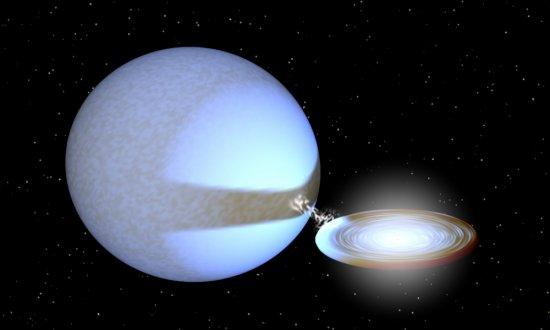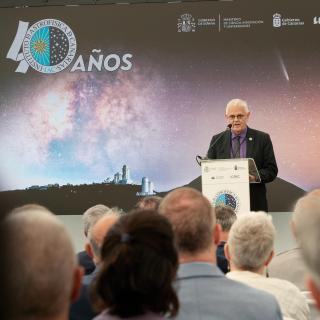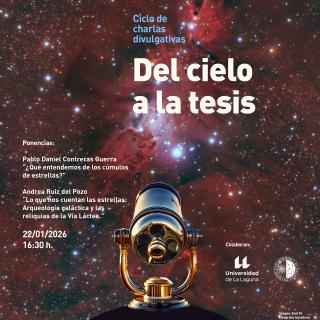Three decades ago one of the first astronomical satellites designed to observe X-rays detected a new type of object: it had a much higher luminosity than any star, but much lower than other types of identified sources, such as the nuclei of active galaxies. They were dubbed, in a not very imaginative way, ultra-high luminosity X rays sources, or ULX for short. Even recently we were still not really sure what they are. Now, a research group which includes the postdoctoral researcher Fabien Grisé, of the Astrophysics Institute of the Canaries (IAC) and the University of La Laguna (ULL) have managed to solve this mystery and they publish their results tomorrow in the journal Nature. It turns out that the mechanism which produces such a large luminosity in the most thoroughly studied ULX is not, as many had hoped, an intermediate mass hole for which astronomers have long been searching.
This source, catalogued as ULX P13 does indeed host a black hole, but it is a “small” one, of stellar type, with less than 15 times the mass of the Sun. In that case why is it so brilliant in X-rays, much brighter than any stellar black hole previously known? The reason is greed: it eats more rapidly than the others.
ULX P13 emits so much energy because it harbours a black hole which consumes fuel at a rate ten times greater than was believed possible: this is one of the most important results of our work,” stressed Grisé, who is at present working at the University of Strasbourg, but who carried out part of this research while he was working in the group directed by Jorge Casares of the IAC, an expert in black holes.
The complete story of what is going on in ULX P13, which is 12 million light years from us, is as follows. To start with it isn´t one object, but two: a binary formed by a supergiant star which has 20 times the mass of the Sun, and a black hole. The black hole orbits the star with a period of 64 days, and absorbs some of the mass of its companion. This material which is being devoured so rapidly by the black hole is the cause of its great brilliance. Black holes do not shine in their own right, but the material which is pulled towards them and ends by falling into them does shine, and very brightly indeed. It is their swansong before being flushed down a cosmic drain.
“ULPX P13 is a very bright X-ray source, much brighter than the black holes in our own Galaxy” explains Grisé. What makes it doubly special is that the star which is feeding the black hole is also brighter than those in other ULX´s. For that reason we have been able to understand what the system is, and measure the rotation of its two components.
The mystery of the nature of the ULX´s became one of the hot topics in astrophysics in the past decade. The newest telescopes allow us to study in ever greater detail the properties of emitting material around black holes, but the ULX´s kept on challenging the researchers just because they could not manage to detect the donor star in any of them.
Understanding ULX P13 has taken several years of observations with X-ray telescopes in space: NASA´s Chandra satellite, and the XMM satellite of the European Space Agency (ESA). In addition, with ground-based telescopes using visible light it was possible to determine the nature of the donor, and to measure its orbit. It is the first time that this has been done for a ULX.
No intermediate black holes
Grisé is of the opinion that the types of observations made for UPX P13 can be applied to many other sources of the same type. “I won´t say that all the ULX sources are stellar sized black holes, but I do think that the majority of them can be explained in this way”.
So we can rule out, for ULX P13 – and if Grisé is right also for the majority of the ULX sources- the hypothesis which up to now has been preferred by many researchers: that the cause of their brilliance is an intermediate mass black hole, of between several hundred and several thousand times the mass of the sun. There is an intensive search for these intermediate class black holes because the current models for the formation of structure in the Universe predict their existence, but up to now not one of them has been detected with any degree of certainty.
“Today we know that in the nuclei of galaxies there are gigantic “supermassive” black holes, which contain millions of times the mass of the Sun” says Casares; “ we also know that very massive stars, after exploding as supernovae, give rise to stellar mass black holes, with masses several times the mass of the Sun. What we don´t know is whether there are any intermediate mass black holes, with masses hundreds or thousands of times the mass of the Sun. Their existence seems to be needed in order to explain how the supermassive black holes have formed, and when the ULX sources were detected in the 80’s many researchers thought that these were the “missing” intermediate mass black holes”.
Grisé acknowledges, all the same, that his data do not preclude the possibility that there are ULX sources containing intermediate mass black holes. “There still could be intermediate mass black holes, but only in those very few ULX sources which are extremely ultrabright”.
A very big appetite
We still need an explanation for the tremendous greed of ULX P13. Why does it eat up the gas of its companion star so quickly? The astrophysicists have a number of possible explanations ready, and none of them imply strange phenomena.
The most probable explanation, they tell us, is that the rapid expansion of the supergiant companion “force feeds” the black hole, obliging it to swallow material more quickly than normal.
Dr. Christian Motch from the University of Strasbourg led the study.
Scientific paper: “A mass of less than 15 solar masses for the black hole in an ultraluminous X-ray source", C. Motch, M. W. Pakull, R. Soria, F. Grisé, G. Pietrzynski (Nature, 9 October 2014). doi: 10.1038/nature13730
Press release by Mónica Salomone.
Contacts:
Fabien Grisé
Postdoctoral Researcher
Observatoire Astronomique
11 rue de l'Université
67000 Strasbourg
France
Office: +33-(0)3-68-85-24-21
Email: fabien.grise [at] astro.unistra.fr (fabien[dot]grise[at]astro[dot]unistra[dot]fr)



